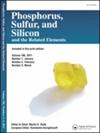季戊四醇衍生二茂铁基二硫代膦酸盐分子内S-S偶联的多态性:结构和计算研究
IF 1.6
4区 化学
Q4 CHEMISTRY, INORGANIC & NUCLEAR
Phosphorus, Sulfur, and Silicon and the Related Elements
Pub Date : 2023-01-01
DOI:10.1080/10426507.2023.2222871
引用次数: 0
摘要
得到了季戊四醇衍生的二茂铁S-S偶联二硫代膦酸盐的4个新多态性(1-4)。四种晶型均在单斜晶系中结晶,但空间群不同。多态性3和多态性4的显著差异在于它们各自的单位细胞参数;同一化合物的第五个多晶体5在正交体系中结晶,我们以前报道过。多态之间的结构偏差通过分子叠加进行,统计值以均方根偏差(RMSD)表示。结构偏差最大的是多态性1 &;4和2 &;4的RMSD约为1.0,而多态3 &;4的差异较小,RMSD约为0.25。从分子构象、晶体排列和氢键网络等方面对五种多晶的固态分子结构进行了研究和讨论。多晶型1-5包含多种分子间和分子内的非经典氢键相互作用,形成氢键超分子结构。在所有的多晶态中,这些氢键相互作用发生在取代的和未取代的二茂铁基部分的氢原子和相邻的二硫代膦酸盐基的硫原子之间。DFT几何优化发现2具有最低的能量,并验证了分子覆盖。反应性指标进一步证明2的反应性最强。本文章由计算机程序翻译,如有差异,请以英文原文为准。

Polymorphism in pentaerythritol-derived ferrocenyl dithiophosphonates with intramolecular S-S coupling: a structural and computational study
Four new polymorphs (1–4) of pentaerythritol-derived ferrocenyl S-S coupled dithiophosphonates were obtained. The four polymorphs all crystallized in the monoclinic system but different space groups. Notable differences between polymorphs 3 and 4 lie in their respective unit cell parameters; a fifth polymorph 5 of the same compound crystallized in the orthorhombic system and was previously reported by us. Structural deviations between polymorphs were performed by molecular overlays and the statistical values were expressed as root mean square deviation (RMSD). The highest structural deviations were between polymorphs 1 & 4 and 2 & 4 with an RMSD of about 1.0 while polymorphs 3 & 4 had a smaller difference with an RMSD of about 0.25. The solid-state molecular organization in the five polymorphs was also studied and discussed in terms of molecular conformation, crystal packing and hydrogen-bonded networks. Polymorphs 1–5 contain a variety of intermolecular and intramolecular non-classical hydrogen bonding interactions which form hydrogen-bonded supramolecular architectures. In all polymorphs, these hydrogen bond interactions were between the hydrogen atoms of the substituted and unsubstituted ferrocenyl moiety and the adjoining sulfur atoms of the dithiophosphonate group. A DFT geometry optimization found that 2 had the lowest energy and verified the molecular overlay. The reactivity indices further proved 2 to be the most reactive.
求助全文
通过发布文献求助,成功后即可免费获取论文全文。
去求助
来源期刊
CiteScore
2.60
自引率
7.70%
发文量
103
审稿时长
2.1 months
期刊介绍:
Phosphorus, Sulfur, and Silicon and the Related Elements is a monthly publication intended to disseminate current trends and novel methods to those working in the broad and interdisciplinary field of heteroatom chemistry.

 求助内容:
求助内容: 应助结果提醒方式:
应助结果提醒方式:


